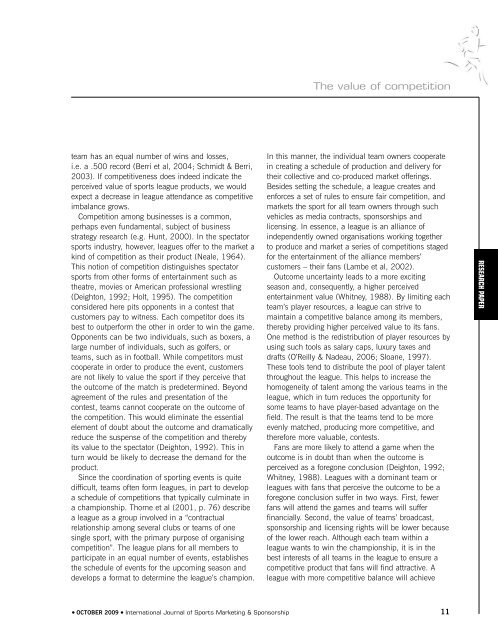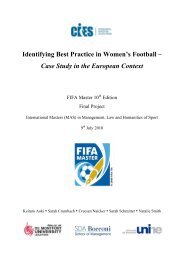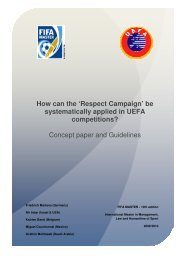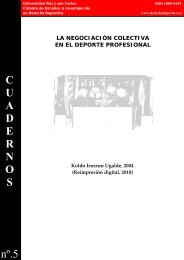Sports Marketing & Sponsorship - FIFA/CIES International University ...
Sports Marketing & Sponsorship - FIFA/CIES International University ...
Sports Marketing & Sponsorship - FIFA/CIES International University ...
- No tags were found...
Create successful ePaper yourself
Turn your PDF publications into a flip-book with our unique Google optimized e-Paper software.
The value of competitionteam has an equal number of wins and losses,i.e. a .500 record (Berri et al, 2004; Schmidt & Berri,2003). If competitiveness does indeed indicate theperceived value of sports league products, we wouldexpect a decrease in league attendance as competitiveimbalance grows.Competition among businesses is a common,perhaps even fundamental, subject of businessstrategy research (e.g. Hunt, 2000). In the spectatorsports industry, however, leagues offer to the market akind of competition as their product (Neale, 1964).This notion of competition distinguishes spectatorsports from other forms of entertainment such astheatre, movies or American professional wrestling(Deighton, 1992; Holt, 1995). The competitionconsidered here pits opponents in a contest thatcustomers pay to witness. Each competitor does itsbest to outperform the other in order to win the game.Opponents can be two individuals, such as boxers, alarge number of individuals, such as golfers, orteams, such as in football. While competitors mustcooperate in order to produce the event, customersare not likely to value the sport if they perceive thatthe outcome of the match is predetermined. Beyondagreement of the rules and presentation of thecontest, teams cannot cooperate on the outcome ofthe competition. This would eliminate the essentialelement of doubt about the outcome and dramaticallyreduce the suspense of the competition and therebyits value to the spectator (Deighton, 1992). This inturn would be likely to decrease the demand for theproduct.Since the coordination of sporting events is quitedifficult, teams often form leagues, in part to developa schedule of competitions that typically culminate ina championship. Thorne et al (2001, p. 76) describea league as a group involved in a “contractualrelationship among several clubs or teams of onesingle sport, with the primary purpose of organisingcompetition”. The league plans for all members toparticipate in an equal number of events, establishesthe schedule of events for the upcoming season anddevelops a format to determine the league’s champion.In this manner, the individual team owners cooperatein creating a schedule of production and delivery fortheir collective and co-produced market offerings.Besides setting the schedule, a league creates andenforces a set of rules to ensure fair competition, andmarkets the sport for all team owners through suchvehicles as media contracts, sponsorships andlicensing. In essence, a league is an alliance ofindependently owned organisations working togetherto produce and market a series of competitions stagedfor the entertainment of the alliance members’customers – their fans (Lambe et al, 2002).Outcome uncertainty leads to a more excitingseason and, consequently, a higher perceivedentertainment value (Whitney, 1988). By limiting eachteam’s player resources, a league can strive tomaintain a competitive balance among its members,thereby providing higher perceived value to its fans.One method is the redistribution of player resources byusing such tools as salary caps, luxury taxes anddrafts (O’Reilly & Nadeau, 2006; Sloane, 1997).These tools tend to distribute the pool of player talentthroughout the league. This helps to increase thehomogeneity of talent among the various teams in theleague, which in turn reduces the opportunity forsome teams to have player-based advantage on thefield. The result is that the teams tend to be moreevenly matched, producing more competitive, andtherefore more valuable, contests.Fans are more likely to attend a game when theoutcome is in doubt than when the outcome isperceived as a foregone conclusion (Deighton, 1992;Whitney, 1988). Leagues with a dominant team orleagues with fans that perceive the outcome to be aforegone conclusion suffer in two ways. First, fewerfans will attend the games and teams will sufferfinancially. Second, the value of teams’ broadcast,sponsorship and licensing rights will be lower becauseof the lower reach. Although each team within aleague wants to win the championship, it is in thebest interests of all teams in the league to ensure acompetitive product that fans will find attractive. Aleague with more competitive balance will achieveRESEARCH PAPER● OCTOBER 2009 ● <strong>International</strong> Journal of <strong>Sports</strong> <strong>Marketing</strong> & <strong>Sponsorship</strong>11
















